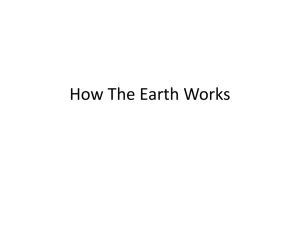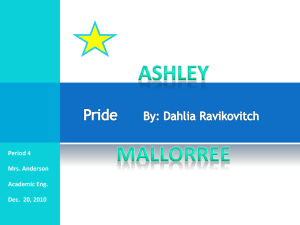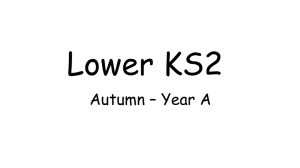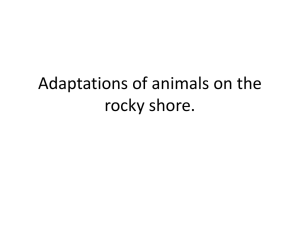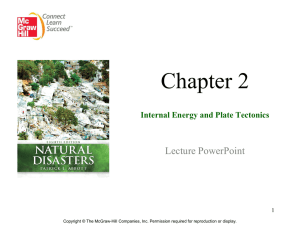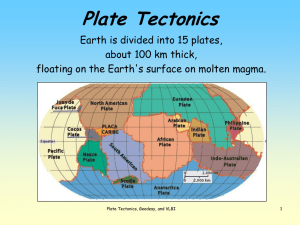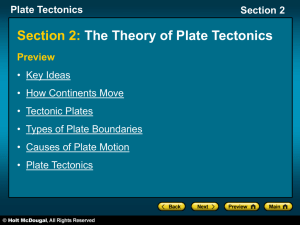Great Ideas in Science: Lecture 9 – Earth as a Planet
advertisement
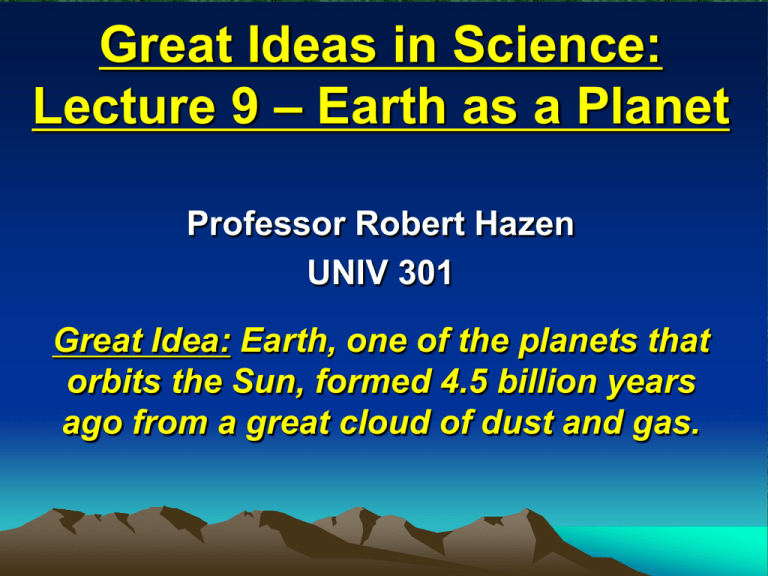
Great Ideas in Science: Lecture 9 – Earth as a Planet Professor Robert Hazen UNIV 301 Great Idea: Earth, one of the planets that orbits the Sun, formed 4.5 billion years ago from a great cloud of dust and gas. Today: Key Ideas About Earth 1. Earth, one of the planets that orbits the Sun, formed 4.5 billion years ago from a great cloud of dust and gas. 2. The surface of our planet changes constantly; no feature is permanent. 3. The entire Earth is still changing, due to the slow convection of soft, hot rocks deep within the planet. 4. Earth materials move in cycles; a change in one cycle affects others. Clues to the Origin of the Solar System Solar System = Objects gravitationally bound to the Sun Clue #1: Planetary Orbits Features of solar system – All planets orbit in the same direction – All planets orbit in the same plane – Most planets rotate in the direction of orbit Clue #2: Distribution of Mass • Almost all mass is in the Sun (99.9%) • Two types of planets – Terrestrial planets – Jovian planets • Other objects – Moons, asteroids, comets The Nebular Hypothesis Terrestrial (Inner) Planets • Mercury, Venus, Earth, Mars – Rocky and relatively small – Mercury and Venus too hot for life – Mars may have had life long ago Terrestrial (Inner) Planets • Mars Exploration – Multiple missions – Found evidence of water Jovian (Outer) Planets Jupiter, Saturn, Uranus, Neptune Jovian (Outer) Planets Jupiter, Saturn, Uranus, Neptune – Layered structure – No solid surface Pluto and the Plutoids – Only 0.3% of Earth’s mass – Three moons – Captured comet or asteroid? – Is it a planet? Asteroids, Comets, and Meteors Asteroids Small rocky bodies Orbit sun Asteroid belt Comets Dirty snowballs Highly elongated orbits Stardust and Deep Impact missions Meteors and Meteorites Meteor showers Original solar system material The Formation of Earth The Great Bombardment Differentiation Heat produced from collisions Dense material sank to center Lighter material rose to surface Layered structure – Core – Mantle – Crust The Formation of the Moon “Big Splash” Large object impacted Earth Parts of mantle blown into orbit Moon formed from this material The Formation of the Moon “Big Splash” The Evolution of Earth’s Atmosphere 1. Volcanoes released N2, CO2, H2, & H2O 2. Large impacts blew off most atmosphere 3. Hydrogen lost by gravitational escape 4. Living organisms introduced oxygen Volcanoes and Earthquakes: Evidence of Earth’s Inner Forces • Volcanoes: Magma breaks through surface Volcanoes and Earthquakes: Evidence of Earth’s Inner Forces Earthquakes – Rocks breaks along fault – Energy transmitted as wave – Tsunamis The Case of the Disappearing Mountains Old Young Deep Time James Hutton at Jedburgh Scotland ca.1790 Deep Time 1. Sediments 2. Burial 3. Uplift 4. Sediments Plate Tectonics Great Idea: Earth is constantly changing, due to the slow convection of soft, hot rocks deep within the planet. Plate tectonics – 6 lines of evidence 1. Physiology: Similar shapes of continents Plate tectonics – 6 lines of evidence 1. Physiology: Shape of continents 2. Seismology: Earth’s inner structure Plate tectonics – 6 lines of evidence 1. 2. Physiology: Shape of continents Seismology: Earth’s inner structure 3. Geology: Distribution of rocks and fossils Plate tectonics – 6 lines of evidence 1. 2. 3. Physiology: Shape of continents Seismology: Earth’s inner structure Geology: Distribution of rocks and fossils 4. Oceanography: Sea floor topography Bruce Heezen and Marie Tharp Plate tectonics – 6 lines of evidence 1. 2. 3. 4. Physiology: Shape of continents Seismology: Earth’s inner structure Geology: Distribution of rocks and fossils Oceanography: Sea floor topography <5 5. Volcanology: Ages of Atlantic volcanoes 95 75 55 125 Plate tectonics – 6 lines of evidence 1. 2. 3. 4. 5. Physiology: Shape of continents Seismology: Earth’s inner structure Geology: Distribution of rocks and fossils Oceanography: Sea floor topography Volcanology: Ages of Atlantic volcanoes 6. Paleomagnetismof sea floor rocks New Support for Plate Tectonics • Measurements of the distance between continents • North America and Europe are separating at ~5 cm per year Earth’s Tectonic Plates Plate Boundaries Three Main Boundary Types – Divergent – Convergent – Transform Divergent Boundaries Convergent Plate Boundaries Three Types: 1. Ocean-ocean Convergent Plate Boundaries Three Types: 1. Ocean-ocean 2. Continent-continent Convergent Plate Boundaries Three Types: 1. Ocean-ocean 2. Continent-continent 3. Ocean-continent Transform Plate Boundary Another Look at Volcanoes and Earthquakes Volcanoes Occur: 1. At Divergent Plate Boundaries 2. Close to Convergent Plate Boundaries 3. Above Hotspots Another Look at Volcanoes and Earthquakes Earthquakes Occur at: 1. Transform Plate Boundaries 2. Convergent boundaries Earth’s Geochemical Cycles Earth materials move in cycles; a change in one cycle affects the others. 1. Atoms recycle; they’re used over and over. Reservoirs (Aluminum can) Hydrologic cycle Atmospheric cycle Rock cycle 2. Energy flows through the system. Geochemical Cycles • Account for all the repositories of that substance. • Document processes by which the substance moves from repository to another. • Gold ROCK CYCLE: Igneous Rocks • Igneous Rocks – Solidify from hot liquid • Types – Extrusive rocks solidify at the surface – Intrusive rocks solidify below surface ROCK CYCLE: Sedimentary Rocks Rocks deposited layer by layer from weathered particles (sand, silt, etc.) or chemicals (i.e., coral). ROCK CYCLE: Metamorphic Rocks • Rocks formed by pressure and heat • Examples – Slate – Schist – Gneiss – Quartzite – Marble Atmospheric Cycle Air mass: Uniform temperature and moisture Weather: State of the atmosphere Climate: Long-term average of weather The General Circulation of the Atmosphere • Circulation powered by Sun – Air heated and rises – Cools and sinks • Prevailing winds – Caused by earth’s rotation Weather Five variables define state of atmosphere –Temperature –Air pressure –Humidity –Cloudiness –Prevailing winds Climate • Gradual change over long periods • Influences on climate – Large bodies of water – Ocean currents – Mountain ranges – Position of tectonic plates – Solar output – Greenhouse gases The Water (Hydrologic) Cycle • The total amount of Earth’s water is constant; the same atoms cycle from one reservoir to another • Total volume ~ 1.4 billion km3 Oceans 97.3% Lakes and Rivers 0.01% Groundwater 0.6% Ice Caps & Glaciers 2.1% Atmosphere 0.001% All life 0.00004% How does water move among reservoirs? Ocean Currents • Redistribute heat across planet Ice Ages As the ice caps and glaciers grow, the sea level drops. Cycle tied to Earth’s tilt and orbit Two facts about water use • A human requires about 2 liters of water per day to survive • The average American uses about 6,000 liters of water per day The Water Table • The water table will drop when discharge exceeds recharge (like a bank) • In the US we “mine” about 100,000,000 gallons of water every day (more than the recharge) • Artificial recharge helps • Urbanization and pollution hurt
